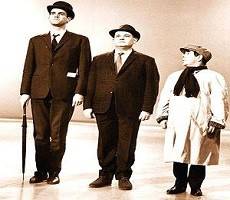May 1, 2014
Hierarchical organisations ‘stifle’ employee productivity, claims CIPD
 Rigid organisational hierarchies hamper the development of management, employee productivity and leadership skills within the workplace, warns the CIPD. Their report, ‘Leadership – easier said than done,’ finds a growing trend in developing the capability of individual leaders and managers, an approach known as ‘distributed leadership’. However, faced with outdated organisational structures and cultures – these managers are unable to apply what they’ve learnt in the training room. The report recommends that leadership development should give greater consideration to the organisation-wide factors that can help or hinder the practical application of great leadership skills by employees at all levels. It urges HR managers to take the next step from training individual leaders, to improving the leadership capacity of the organisation as a whole; focusing on understanding what kind of leadership it requires and what changes are needed.
Rigid organisational hierarchies hamper the development of management, employee productivity and leadership skills within the workplace, warns the CIPD. Their report, ‘Leadership – easier said than done,’ finds a growing trend in developing the capability of individual leaders and managers, an approach known as ‘distributed leadership’. However, faced with outdated organisational structures and cultures – these managers are unable to apply what they’ve learnt in the training room. The report recommends that leadership development should give greater consideration to the organisation-wide factors that can help or hinder the practical application of great leadership skills by employees at all levels. It urges HR managers to take the next step from training individual leaders, to improving the leadership capacity of the organisation as a whole; focusing on understanding what kind of leadership it requires and what changes are needed.
Ksenia Zhelthoukhova, Research Adviser at the CIPD, comments: “It’s not enough to have one or two strong leaders at the top of an organisation. Everyone, particularly those on the front line, needs to be empowered to respond effectively to evolving external challenges and help take others with them on that journey.
“However, our concern is that rigid organisational systems, characterised by hierarchy, short-term focus, individualism and ‘us’ and ‘them’ mentality, stifle the productivity of employees, undermining their ability to lead on the organisational agenda from the front line.”
The three main recommendations are:
- Define the type of leadership and management needed and put appropriate training and succession planning programmes in place. For example, some companies may be looking to grow the next generation of senior leaders, and need to identify potential among junior managers, whilst some may look to achieve greater employee productivity.
- Training of leader and manager capability should be aligned to the needs of the organisation. HR also needs to talk to staff about their learning requirements and any questions they might have over organisational change.
- HR should identify and influence key players with the power to change the status quo. Implementing formal processes is not enough; they must also understand where individuals are demonstrating leadership behaviours and where shifts can be made in the organisational structure.
“In order to be effective, leadership development has to be supported with organisational practices that empower the workforce and foster engagement: team-working, behaviour-based performance management and succession planning, collective reward and recognition, to name just a few. Forward-looking organisations are using innovative methods of job and organisation design, to create agile organisational environments and cultures that enable leadership at all levels of the business.”













